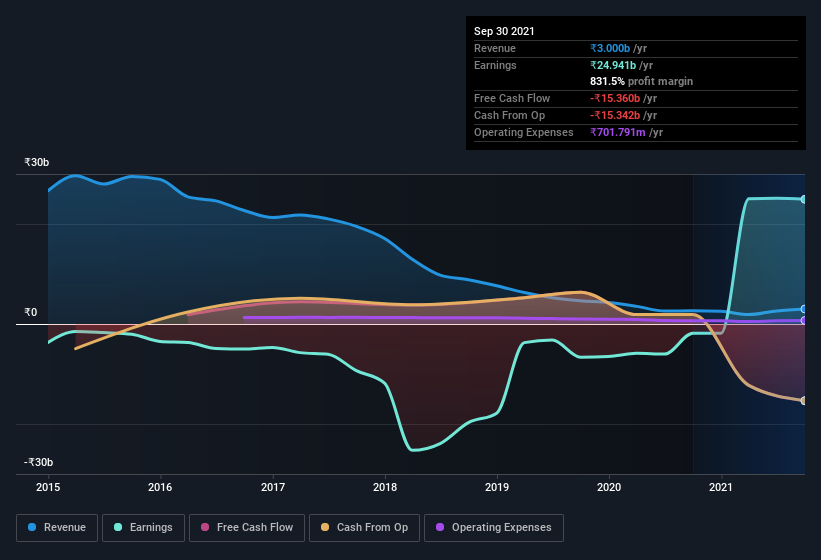Shareholders In SEL Manufacturing (NSE:SELMC) Should Look Beyond Earnings For The Full Story

SEL Manufacturing Company Limited (NSE:SELMC) recently released a strong earnings report, and the market responded by raising the share price. Despite the strong profit numbers, we believe that there are some deeper issues which investors should look into.
View our latest analysis for SEL Manufacturing

A Closer Look At SEL Manufacturing's Earnings
In high finance, the key ratio used to measure how well a company converts reported profits into free cash flow (FCF) is the accrual ratio (from cashflow). In plain english, this ratio subtracts FCF from net profit, and divides that number by the company's average operating assets over that period. This ratio tells us how much of a company's profit is not backed by free cashflow.
As a result, a negative accrual ratio is a positive for the company, and a positive accrual ratio is a negative. That is not intended to imply we should worry about a positive accrual ratio, but it's worth noting where the accrual ratio is rather high. That's because some academic studies have suggested that high accruals ratios tend to lead to lower profit or less profit growth.
Over the twelve months to September 2021, SEL Manufacturing recorded an accrual ratio of 2.05. As a general rule, that bodes poorly for future profitability. And indeed, during the period the company didn't produce any free cash flow whatsoever. Even though it reported a profit of ₹24.9b, a look at free cash flow indicates it actually burnt through ₹15b in the last year. It's worth noting that SEL Manufacturing generated positive FCF of ₹1.9b a year ago, so at least they've done it in the past. Having said that, there is more to consider. We can look at how unusual items in the profit and loss statement impacted its accrual ratio, as well as explore how dilution is impacting shareholders negatively. One positive for SEL Manufacturing shareholders is that it's accrual ratio was significantly better last year, providing reason to believe that it may return to stronger cash conversion in the future. As a result, some shareholders may be looking for stronger cash conversion in the current year.
Note: we always recommend investors check balance sheet strength. Click here to be taken to our balance sheet analysis of SEL Manufacturing.
One essential aspect of assessing earnings quality is to look at how much a company is diluting shareholders. As it happens, SEL Manufacturing issued 9,900% more new shares over the last year. Therefore, each share now receives a smaller portion of profit. To celebrate net income while ignoring dilution is like rejoicing because you have a single slice of a larger pizza, but ignoring the fact that the pizza is now cut into many more slices. You can see a chart of SEL Manufacturing's EPS by clicking here.
How Is Dilution Impacting SEL Manufacturing's Earnings Per Share? (EPS)
SEL Manufacturing was losing money three years ago. And even focusing only on the last twelve months, we don't have a meaningful growth rate because it made a loss a year ago, too. But mathematics aside, it is always good to see when a formerly unprofitable business come good (though we accept profit would have been higher if dilution had not been required). Therefore, one can observe that the dilution is having a fairly profound effect on shareholder returns.
In the long term, if SEL Manufacturing's earnings per share can increase, then the share price should too. However, if its profit increases while its earnings per share stay flat (or even fall) then shareholders might not see much benefit. For the ordinary retail shareholder, EPS is a great measure to check your hypothetical "share" of the company's profit.
The Impact Of Unusual Items On Profit
Given the accrual ratio, it's not overly surprising that SEL Manufacturing's profit was boosted by unusual items worth ₹27b in the last twelve months. While we like to see profit increases, we tend to be a little more cautious when unusual items have made a big contribution. We ran the numbers on most publicly listed companies worldwide, and it's very common for unusual items to be once-off in nature. And, after all, that's exactly what the accounting terminology implies. We can see that SEL Manufacturing's positive unusual items were quite significant relative to its profit in the year to September 2021. All else being equal, this would likely have the effect of making the statutory profit a poor guide to underlying earnings power.
Our Take On SEL Manufacturing's Profit Performance
SEL Manufacturing didn't back up its earnings with free cashflow, but this isn't too surprising given profits were inflated by unusual items. Meanwhile, the new shares issued mean that shareholders now own less of the company, unless they tipped in more cash themselves. On reflection, the above-mentioned factors give us the strong impression that SEL Manufacturing'sunderlying earnings power is not as good as it might seem, based on the statutory profit numbers. If you'd like to know more about SEL Manufacturing as a business, it's important to be aware of any risks it's facing. At Simply Wall St, we found 5 warning signs for SEL Manufacturing and we think they deserve your attention.
In this article we've looked at a number of factors that can impair the utility of profit numbers, and we've come away cautious. But there are plenty of other ways to inform your opinion of a company. Some people consider a high return on equity to be a good sign of a quality business. While it might take a little research on your behalf, you may find this free collection of companies boasting high return on equity, or this list of stocks that insiders are buying to be useful.
New: Manage All Your Stock Portfolios in One Place
We've created the ultimate portfolio companion for stock investors, and it's free.
• Connect an unlimited number of Portfolios and see your total in one currency
• Be alerted to new Warning Signs or Risks via email or mobile
• Track the Fair Value of your stocks
This article by Simply Wall St is general in nature. We provide commentary based on historical data and analyst forecasts only using an unbiased methodology and our articles are not intended to be financial advice. It does not constitute a recommendation to buy or sell any stock, and does not take account of your objectives, or your financial situation. We aim to bring you long-term focused analysis driven by fundamental data. Note that our analysis may not factor in the latest price-sensitive company announcements or qualitative material. Simply Wall St has no position in any stocks mentioned.
Have feedback on this article? Concerned about the content? Get in touch with us directly. Alternatively, email editorial-team (at) simplywallst.com.
About NSEI:SELMC
Slight and slightly overvalued.
Market Insights
Community Narratives




